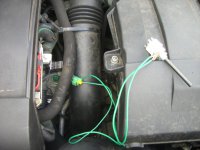It always happens at the worst times. You’re stuck in a traffic jam and your eng temp needle is rising but where you normally trust your engine cooling fan to switch on – it doesn’t – and the temp goes on and on rising towards the red band- “Warning engine overheat” “Oh Hell’s bells!”. Turn your internal heater on full heat and blower on full blast to get the temps down as that’s a kind of radiator fan too of course.
OK you fixed the fault- you think- but how can you test your radiator fan without running your engine temperature up to dangerous head gasket territory again?
Answer- You fool your engine into thinking that it’s getting hot when it’s not

Your engine temp sensor is usually near or in the thermostat housing, here it is on a 1.6, coloured green on mine.

First of all you need to get a linear potentiometer (variable resistor) of the right sort of range. Here’s a chart of eng temp against resistance (ohms) for the Stilo range. As you can see, it ranges from 170ohms at 100 degrees C to around 15k ohms at minus 20 degrees. So you need a potentiometer that goes from zero to say 10k. Get a linear potentiometer (rather than a logarithmic one) so it’s nice and predictable

Ok, back at base, select resistance and check out which terminals give you the range of resistances you want, usually the centre of the three and one of the outside ones.

Solder on some wires and check it again with your multimeter.

Get used to how the resistance alters by watching your multimeter as you turn the potentiometer adjuster so you can predict what’s happening when you have it attached to the car

OK bonnet up and here’s your engine temp sensor on the 1.6, coloured green. Had to unclip a coolant pipe and move it out the way for this shot
Set your potentiometer to simulate around 20 degrees of engine temp(around 2k to 3k ohms) setting so your car will start nicely and plug in your wires like this. Make sure the bare wires don’t touch one another.
Ok just turn on your ignition now and check your dashboard. Things should look fairly normal.

Now move the potentiometer to lower the resistance towards 1K. Now check your dashboard- Oh look, it now says engine temp is Normal even though your engine is actually cold. Cool!
Now keep lowering the resistance and the engine temp will go to the red and you should hear the beep of “Coolant overheat” or similar. If you take the resistance completely down to zero it will probably fire up a "Sensor failure" warning as it goes out of normal range but it will reset itself when you put some acceptable resistance back in again
OK everything is working fine. Turn your ignition off and put the resistance back to the around 2k to 3k ohms start position so your engine stops fretting again.
Now you’re going to start your engine so you can check the fan operation
Make sure no wires are anywhere near anything rotating of course and with the pot set at around 2k – 3k so everything is normal and start the engine. All fine? OK now decrease the resistance as before. Your engine revs will start to drop significantly as it thinks it's warming up fast. When the resistance is down towards 170ohms the radiator fan should start. If you have an assistant in the driver’s seat you can see exactly where the engine temp gauge is when the radiator fan starts. Great! Now you know the fan should definitely start when the coolant temp gets to there.
CHECKING THE ENGINE TEMP SENSOR

Of course, the fault could be the engine temp sensor itself although they’re pretty reliable. There’s various ways you can check this. The simplest is just checking its resistance compares with the chart above at different temperatures.
Another is to check the return voltage. It’s a 5v input and the output voltage varies with temperature and so you can back probe it with a multimeter or, if you have a scope you can chart the voltage change as the engine warms up
Overheating in a traffic jam is not good for Stilo cred. Stay cool!
OK you fixed the fault- you think- but how can you test your radiator fan without running your engine temperature up to dangerous head gasket territory again?
Answer- You fool your engine into thinking that it’s getting hot when it’s not

Your engine temp sensor is usually near or in the thermostat housing, here it is on a 1.6, coloured green on mine.

First of all you need to get a linear potentiometer (variable resistor) of the right sort of range. Here’s a chart of eng temp against resistance (ohms) for the Stilo range. As you can see, it ranges from 170ohms at 100 degrees C to around 15k ohms at minus 20 degrees. So you need a potentiometer that goes from zero to say 10k. Get a linear potentiometer (rather than a logarithmic one) so it’s nice and predictable

Ok, back at base, select resistance and check out which terminals give you the range of resistances you want, usually the centre of the three and one of the outside ones.

Solder on some wires and check it again with your multimeter.

Get used to how the resistance alters by watching your multimeter as you turn the potentiometer adjuster so you can predict what’s happening when you have it attached to the car

OK bonnet up and here’s your engine temp sensor on the 1.6, coloured green. Had to unclip a coolant pipe and move it out the way for this shot
Set your potentiometer to simulate around 20 degrees of engine temp(around 2k to 3k ohms) setting so your car will start nicely and plug in your wires like this. Make sure the bare wires don’t touch one another.
Ok just turn on your ignition now and check your dashboard. Things should look fairly normal.

Now move the potentiometer to lower the resistance towards 1K. Now check your dashboard- Oh look, it now says engine temp is Normal even though your engine is actually cold. Cool!
Now keep lowering the resistance and the engine temp will go to the red and you should hear the beep of “Coolant overheat” or similar. If you take the resistance completely down to zero it will probably fire up a "Sensor failure" warning as it goes out of normal range but it will reset itself when you put some acceptable resistance back in again
OK everything is working fine. Turn your ignition off and put the resistance back to the around 2k to 3k ohms start position so your engine stops fretting again.
Now you’re going to start your engine so you can check the fan operation
Make sure no wires are anywhere near anything rotating of course and with the pot set at around 2k – 3k so everything is normal and start the engine. All fine? OK now decrease the resistance as before. Your engine revs will start to drop significantly as it thinks it's warming up fast. When the resistance is down towards 170ohms the radiator fan should start. If you have an assistant in the driver’s seat you can see exactly where the engine temp gauge is when the radiator fan starts. Great! Now you know the fan should definitely start when the coolant temp gets to there.
CHECKING THE ENGINE TEMP SENSOR

Of course, the fault could be the engine temp sensor itself although they’re pretty reliable. There’s various ways you can check this. The simplest is just checking its resistance compares with the chart above at different temperatures.
Another is to check the return voltage. It’s a 5v input and the output voltage varies with temperature and so you can back probe it with a multimeter or, if you have a scope you can chart the voltage change as the engine warms up
Overheating in a traffic jam is not good for Stilo cred. Stay cool!

